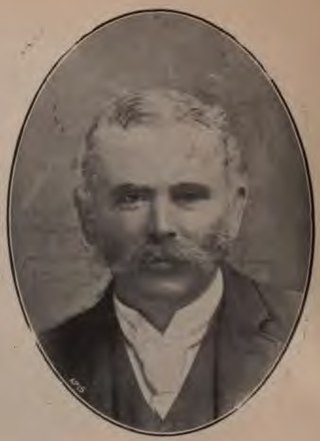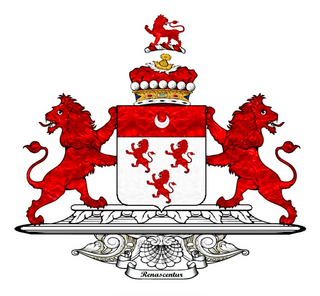Related Research Articles

Fractional-reserve banking is the system of banking operating in almost all countries worldwide, under which banks that take deposits from the public are required to hold a proportion of their deposit liabilities in liquid assets as a reserve, and are at liberty to lend the remainder to borrowers. Bank reserves are held as cash in the bank or as balances in the bank's account at the central bank. The country's central bank determines the minimum amount that banks must hold in liquid assets, called the "reserve requirement" or "reserve ratio". Most commercial banks hold more than this minimum amount as excess reserves.
Arbuthnot & Co was a mercantile bank, based in Madras, India. It had been founded as Francis Latour & Co in the late 18th century and then became Arbuthnot De Monte & Co. It failed spectacularly on 22 October 1906.
The Panic of 1796–1797 was a series of downturns in credit markets in both Great Britain and the newly established United States in 1796 that led to broader commercial downturns. In the United States, problems first emerged when a land speculation bubble burst in 1796. The crisis deepened when the Bank of England suspended specie payments on February 25, 1797 under the Bank Restriction Act of 1797. The Bank's directors feared insolvency when English account holders, who were nervous about a possible French invasion, began withdrawing their deposits in sterling rather than bank notes. In combination with the unfolding collapse of the U.S. real estate market's speculative bubble, the Bank of England's action had deflationary repercussions in the financial and commercial markets of the coastal United States and the Caribbean at the start of the 19th century.

The Kidwelly and Llanelly Canal was a canal and tramroad system in Carmarthenshire, Wales, built to carry anthracite coal to the coast for onward transportation by coastal ships. It began life as Kymer's Canal in 1766, which linked pits at Pwll y Llygod to a dock near Kidwelly. Access to the dock gradually became more difficult as the estuary silted up, and an extension to Llanelli was authorised in 1812. Progress was slow, and the new canal was linked to a harbour at Pembrey built by Thomas Gaunt in the 1820s, until the company's own harbour at Burry Port was completed in 1832. Tramways served a number of collieries to the east of Burry Port.

Owen Cosby Philipps, 1st Baron Kylsant was a British businessman and politician, jailed in 1931 for producing a document with intent to deceive.

Abel Thomas was a Welsh Liberal politician and lawyer.
The bank officially known as the Aberystwith and Tregaron Bank was established at Aberystwyth, Cardiganshire in the beginning of the 19th century and was locally known as ‘Banc y Ddafad Ddu’, because the bank notes were imprinted with an engraving of a black sheep. The Bank later established a branch at Tregaron
Bank y Llong was a Welsh bank. It got its name from an engraving of a ship decorating its bank notes. It was probably the first bank in Aberystwyth and was founded soon after the removal of the Custom House from Aberdyfi to Aberystwyth, around 1762.
The Carmarthen Furnace Bank is a bank established in Carmarthenshire in the 18th century as a result of the efforts of a Welsh entrepreneur and businessman called John Morgan. The banking business started by issuing tokens to facilitate an iron and tin works operation and then developed into a full-fledged bank. However, few records of the works, or the bank, exist.
The British Iron Company was formed in 1824 to smelt and manufacture iron and to mine ironstone, coal, etc. It was re-formed as the New British Iron Company in 1843 and liquidated itself in 1892.
David Pugh was a Welsh landowner and Liberal Party politician who sat in the House of Commons from 1857 until 1868 and again from 1885 until his death in 1890.
The Llandovery Bank was established in 1799 in Llandovery, Wales, in the premises known as the King’s Head on Stone Street, where it remained for many years. The bank was locally known as the ‘Black Ox Bank’ because of the bank notes having been embellished with an engraving on the left hand side of a Welsh black ox.
Llanelly Bank was a 19th-century bank based in the Welsh town of Llanelli.
David Morris & Sons was a bank which was established in Carmarthenshire, Wales in the 18th century. It now a constituent part of The Royal Bank of Scotland Group.
The Brecon Old Bank was founded in Brecon in 1778 by John Wilkins (1713–1784), who was highly regarded by the directors of the Bank of England.

The Dolaucothi Estate is situated about 1 mile (1.6 km) north-west of the village of Caio up the Cothi Valley in the community of Cynwyl Gaeo, in Carmarthenshire, Wales. Dolaucothi means ‘the meadows of the Cothi’.
The Arbuthnot Bank crash led to the fall of Arbuthnot & Co, a premier British-owned financial institution in Madras Presidency, British India in October 1906. The incident is considered to be one of the key events which influenced the Indian independence movement in Tamil Nadu.
David Morris was a British Whig and Liberal politician, and banker.

The Hon. William Henry Yelverton was a Whig politician who served as MP for Carmarthen Boroughs from 1832 to 1835. Yelverton inherited considerable lands and industry from his family and from his marriage to Elizabeth Lucy Morgan.
Henry Jones-Davies was a Carmarthenshire farmer who became active in public life and a pioneer of agricultural co-operation.
References
- 1 2 3 4 5 6 7 8 9 10 11 Early Banks in West Wales, by Francis Green (in West Wales Historical Records, The Annual Magazine of The Historical Society of West Wales, Volume VI, edited by Francis Green, Printed by W. Spurrell & Son, 1916)
- ↑ Carmarthenshire Antiquarian Society archives
- ↑ Anon., British Losses by Bank Failures, 1858